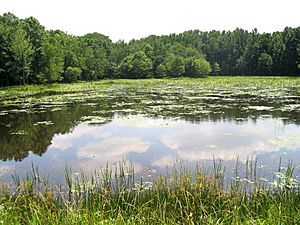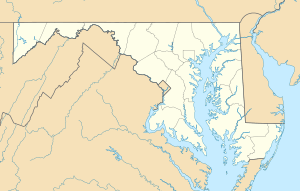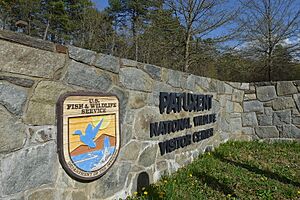Patuxent Wildlife Research Center facts for kids
Quick facts for kids Patuxent Wildlife Research Center |
|
|---|---|

National Wildlife Visitor Center (FWS)
10901 Scarlet Tanager Loop Laurel, MD 20708 |
|
| Location | Prince George's County, Maryland, United States |
| Nearest city | Laurel, Maryland |
| Governing body | U.S. Geological Survey |
| Website | EESC/Patuxent |
The Patuxent Wildlife Research Center is a special place in Laurel, Maryland. It's where scientists study animals and their homes. This center is part of the Eastern Ecological Science Center (EESC). The EESC is a big part of the U.S. Geological Survey (USGS).
The Patuxent facility is located on the Patuxent Research Refuge. This refuge is a huge area, about 12,841 acres (52 square kilometers). The U.S. Fish and Wildlife Service (FWS) manages this land. It is the only National Wildlife Refuge in the United States created just for wildlife research.
What the Center Does
The Patuxent Wildlife Research Center started in 1936. It was the first place in the U.S. to experiment with wildlife. Its main job is to study wildlife and the environment. Scientists here share what they learn with people who manage America's natural resources. They also help put their research into action. This helps improve how we care for nature.
Patuxent's scientists have made big discoveries. They have helped protect many parts of nature. This includes migratory birds and endangered species. They also study wetlands, how to manage waterfowl (like ducks and geese), and how to protect animals from pollution. Their work helps manage national parks and wildlife refuges.
The Center runs important national programs. One is the North American Bird Banding Program. This program tracks birds by putting tiny bands on their legs. The Center's information, databases, and online tools are used worldwide. They help manage living resources everywhere.

This center is a federal research facility. It supports programs within the United States Department of the Interior. The USGS Biological Resources Division works with others. They gather information needed to manage America's living resources.
The center also gets money from other groups. These groups benefit from the research. Other partner organizations also help fund the center.
A Look at History
The land where the Patuxent Research Refuge sits was mostly farmland. This was true from colonial times until after World War I. Important families like the Snowdens and Duvalls owned much of the land. You can still see their history in the area. Two old homes, including Snowden Hall, are on the refuge. There are also 19 cemeteries with headstones from these families.
In 1991, a large part of the refuge was added. About 8,100 acres (33 square kilometers) came from Fort George G. Meade. This area is called the "North Tract." The Patuxent River divides the refuge into two main parts. Long ago, old bridges like Duvall Bridge connected different counties. Today, a newer Duvall Bridge exists. Only cement posts remain from Lemon's Bridge. An old Telegraph Road once linked Baltimore and Washington. You can still see century-old telegraph poles along this road.
In 1946, scientists at Patuxent made an important discovery. They found that a pesticide called DDT was harming wildlife. It was killing animals in trees and many fish in the Patuxent River. This research helped show how dangerous DDT was.
In 2017, the Patuxent Wildlife Research Center ended a long-running program. For 51 years, they had worked to breed and train whooping cranes. These cranes were then released into the wild. The 75 birds from the program were moved. They went to places like the International Crane Foundation and the Calgary Zoo. These other groups continued the important breeding work.
Nearby Fort Meade
Fort George G. Meade is an active Army base. It is located close to the research center. In October 1991, about 7,600 acres (31 square kilometers) were moved from the base. This land became part of the Patuxent National Research Refuge. Another 500 acres (2 square kilometers) were added in January 1993.
In 2007, there was a report about Fort Meade's expansion. It mentioned plans for two new golf courses. The report said these courses could harm the Patuxent Research Refuge. The Army responded by saying they would try to limit damage. They felt the golf courses were important for soldiers and their families.
The historic golf course at Fort Meade closed on May 1, 2012. As of June 2022, no new golf courses had been built.
See also




